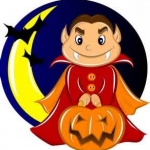When my kids were younger, Halloween brought out their desires. Whether the costumes represented a superhero, a butterfly, or a Star Wars character, they typically chose embodiments that might not be quite possible in real life . . . and which made them all the more desirable.
It’s actually no different than adults. We often choose costumes that are completely different than our real selves, yet which just might – maybe, possibly – reflect a hidden desire. When the husband wears a mask to hand out candy, he often gravitates to former presidents or the devil … which, yes, now concerns me.
At any rate, enter the tween and teen years, and the not-quite-possible desires become just a little scarier – for me, at least. Take, for example, the vampire rage, fueled by books and movies such as the Twilight series. It scares me mainly because I don’t understand it, having never succumbed to the appeal, and partly, I guess, because of the whole blood thing. Broken bones, I’m your girl. Blood . . . not so much.
It is certainly not new. My generation had “Interview With the Vampire,” and generations before that had “Dracula.” Fangs are an absolute essential at Halloween, often whether one’s costume demands them or not. But as a devoted non-fan of the fantasy/sci-fi/gothic/paranormal realm, I never paid much attention. Unless they were made of wax and came in pretty colors.
Now that I’m seeing the blood lust – so to speak – in my kids’ generation, however, I’m forced to ask myself, what gives? From the perspective of a reasonably shallow, not-very-interested-in-the-psychological-history-type mom, what exactly is the appeal of vampires to young people?
And after asking around a bit, I think I’ve found a possible answer. In part, at least, it seems to be about what most of us start thinking about at that age: Sex. Or romance. Or love. Or lust. Or whatever they’re calling it these days. As one high schooler said, “It’s about romance, and the bad boy vs. good boy thing. Wanting what you you’re not supposed to have. Having what you’re not supposed to want.”
So maybe it’s not about drinking human blood, which would make at least one mother (cough*ME*cough) feel better (in fact, the Twilight vampires survive on animal blood.) Maybe it’s all simply another way for young people to process the changing nature of their worlds as they mature. Budding sexuality, norms vs. desires, good and evil – these all contribute to teen angst in one form or another, and for some, the vampire genre seems a positive way to channel that angst.
Hollywood hasn’t hurt the cause, either. Casting beautiful young women and gorgeous young men in the main roles has been happening since the dawn of film, and teen movies are no exception. One of my “vampire advisers” suggested that young girls love werewolves because of Taylor Lautner in the Twilight series. Put George Clooney in there, and I guess I could see it.
And let’s not forget the powers. Vampires have powers, and really, who does not want powers? Although unclear on the concept of who can do what to whom, I’m beginning to understand the appeal, especially to teens and tweens. At a time when they’ve probably never felt more powerless, vampire mythology can empower them. It gives them a safe place to escape, to envision themselves powerful – which is the first step to getting there.
Interestingly, for all of the media hype and focus on teens and sex, the teen television shows that embrace teen sex as a given, and the barrage of sexual images with which our kids are faced on a daily basis, the main characters in “Twilight” don’t have sex before marriage. Without getting into the logistics of vampire/human sexuality, because frankly I haven’t had breakfast, I found that detail noteworthy.
In a way, then, I can begin to see the appeal of vampires. If I look at them as either simply an outlet for burgeoning sexual curiosity, or even the oft-analyzed “good girl/bad boy” relationship, I realize that enjoying the genre does not necessarily mean they want to actually sharpen their teeth and drink someone’s blood. I was being too literal.
Having said that, I need to start thinking about my own costume, something that will reflect a hidden desire or a stifled part of myself and which will, as always, include a turtleneck.

